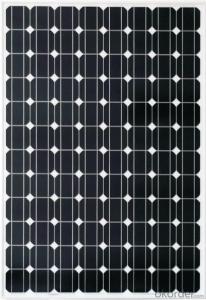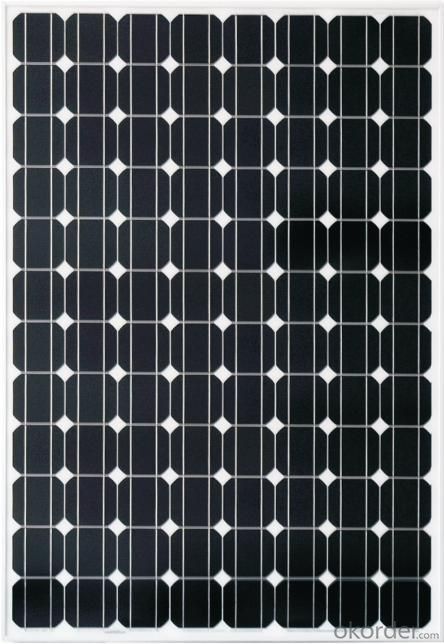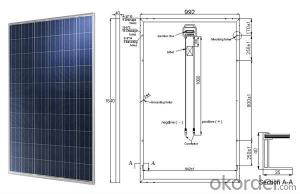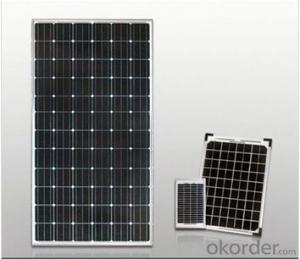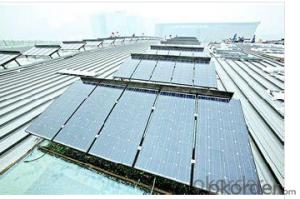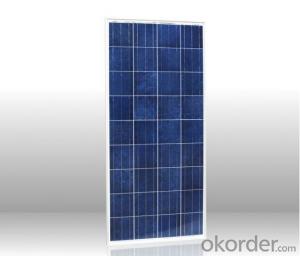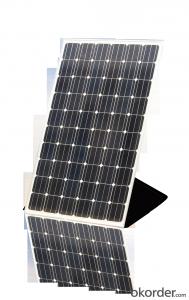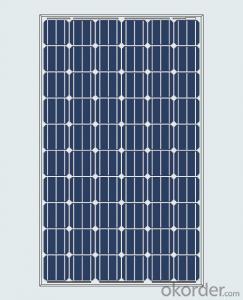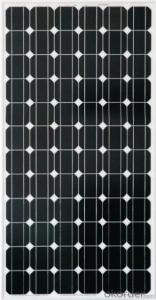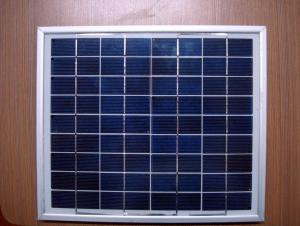White House Solar Panels - Monocrystalline Solar Module 280W
- Loading Port:
- China Main Port
- Payment Terms:
- TT OR LC
- Min Order Qty:
- -
- Supply Capability:
- -
OKorder Service Pledge
OKorder Financial Service
You Might Also Like
Solar Monocrystalline (210W-225W)
Introduction of Solar Monocrystalline (210W-225W)
Solar modules use light energy (photons) from the sun to generate electricity through the photovoltaic effect. The majority of modules use wafer-based crystalline silicon cells or thin-film cells based on cadmium telluride or silicon. The structural (load carrying) member of a module can either be the top layer or the back layer. Cells must also be protected from mechanical damage and moisture. Most solar modules are rigid, but semi-flexible ones are available, based on thin-film cells. These early solar modules were first used in space in 1958.
CNBM Solar photovoltaic (PV) Panel is designed for large electrical power requirements. It is the optimal choice for both on-grid and off-grid power systems. CNBM Solar panel offers high performance of power per square foot of solar array. Monocrystalline silicon(c-Si): often made using the Czochralski process. Single-crystal wafer cells tend to be expensive, and because they are cut from cylindrical ingots, do not completely cover a square solar cell module without a substantial waste of refined silicon. Hence most c-Si panels have uncovered gaps at the four corners of the cells.
Characteristics of Solar Monocrystalline (210W-225W)
I. Solar Cell : High efficiency crystalline solar cell. Even if under the weak light, the solar module can produce maximum power output.
II. Tempered glass (toughened glass): Anti-reflecting coating and high transmission rate glass increase the power output and mechanical strength of solar module.
III. EVA and TPT: Using high quality EVA and TPT to prevent destroying and water.
IV. AI frame: Without screw, corner connection. 6 holes on the frame can be installed easily.
V. Junction box: Multi function junction box with water proof.
VI. Long lifetime: ≥25 years; Less power decrease.
VII. Good performance of preventing from atrocious weather such as wind and hails.
VIII. Resisting moisture and etching effectively, not effected by geology.
IX. The certificate issued by international authority: UL, TUV, IEC, VDE, CE.
Standard Test Conditions of Solar Monocrystalline (210W-225W)
The opto-electrical specifications shown below are stabilized values being measured at Standard Test Conditions, Irradiance: 1000W/m2, Spectrum: AM1.5 at 25°C, The info below is subject to manufacturing tolerances. Where appropriate minutes of measurement are available and are used for the dimensioning of the installation.
Advantages of Solar Monocrystalline (210W-225W)
• CNBM Solar performance guarantees for 25 years
• 10 years guarantee for workmanship
• Timeliness of delivery
• Quality Products certified (TÜV, UL, CE, VDE, ISO)
CNBM International Corporation's products including Monocrystalline Solar Panel, Polycrystalline Solar Panel have received and enjoyed famous reputation in many countries and regions in the world .As a solar panel manufacturer in China, we strive to provide our customers with excellent service, superior products and unmatched value.
- Q: What is the payback period for solar panels?
- The payback period for solar panels refers to the time it takes for the savings from reduced energy bills to equal the initial investment in installing the solar panels. The payback period can vary depending on factors such as the cost of the panels, the amount of sunlight in the location, and the local electricity rates. On average, the payback period for solar panels is around 5 to 10 years, but it can be shorter or longer depending on these factors.
- Q: i already have solar/gas water heating, but was wondering if getting solar panels for electricity installed was a good idea.
- Why of course. Just buying them is the big buzz. Companies are doing thousands if not millions of dollars a month only by selling Solar Panel. I did a little search and I found that it costs 7000$ to install solar panels for an average roof. If you're a hardcore green, then Bon Appétit, I'm not preventing you to buy it. All I'm just saying is that it'll take months if not years to get that money back. It is good for electricity, and I saw it worked on a company building called Better Place, so save the world!
- Q: Can solar panels be used in areas with high levels of chemical pollutants?
- Yes, solar panels can be used in areas with high levels of chemical pollutants. While it is true that pollutants can potentially affect the efficiency and performance of solar panels, proper maintenance and cleaning can mitigate these effects. Additionally, advancements in solar panel technology have made them more resilient to environmental factors, including chemical pollutants.
- Q: Can solar panels be installed on a fire station or emergency services building?
- Yes, solar panels can be installed on a fire station or emergency services building. In fact, many fire stations and emergency services buildings have embraced solar energy as a sustainable and cost-effective solution. Solar panels can help these facilities generate their own electricity, reduce utility bills, and lower their carbon footprint. Additionally, the availability of rooftop space on such buildings often makes them suitable for solar panel installation.
- Q: We are looking in to buy solar panels for our house. The payment has to be around or under $4000. Our house is a 4 bedroom and 3 bath 2-story house. (Around 2500 sq. ft.) Where can we get the solar panels? Also: Will it heat our water? When we get the solar panels, what direction do they have to be facing?
- The crisis is that it's so high priced to have mounted and as you assert it's going to take decades earlier than you honestly begin saving above what the install rate used to be, I for my part might now not cross forward and make that kind of funding, it might be extra lucrative to hold the cash in a constructing society, get the curiosity from it and use that to pay to your electrical energy however the important factor that I have towards sun Panels is that until you keep in that condo for a minimum of twenty 5 years you'll now not succeed in the factor in which you're saving and to capitalise on it you might need to keep there for decades extra, so you'll now not have the choice of relocating condo with out wasting your funding and on the second having sun panels does now not develop the significance of the estate, it's only a well promoting factor, while you purchase your new condo, you might commonly need to begin everywhere once more after which given that of the years will on no account reside lengthy ample to obtain any improvement from it.
- Q: I installed a 60watt solar panel on the top of my patio/pergola. This is wired to a charge controller then a battery in my basement. Do I need to run a ground from the solar panel? If so, whats the easiest way to do so? Is a wire attached to the aluminum frame then connected to a foot long rod into the ground enough?
- Although okorder
- Q: Can solar panels be installed in areas with high levels of air pollution?
- Yes, solar panels can be installed in areas with high levels of air pollution. While air pollution may slightly reduce the efficiency of solar panels by blocking sunlight, they can still generate electricity even in polluted environments. Regular maintenance and cleaning of the panels can help mitigate any potential impact on their performance. Additionally, solar energy remains a sustainable and environmentally friendly option, regardless of air pollution levels.
- Q: Can solar panels be used to power electric vehicles?
- Yes, solar panels can be used to power electric vehicles. Solar panels can convert sunlight into electricity, which can then be stored in a battery and used to power an electric vehicle. This helps reduce dependence on fossil fuels and promotes sustainable transportation.
- Q: OK so how do these solar panels supplement the AC from the grid? Like do they invert the output of the solar panels and sync two AC sources together? If so how and with what? Or do they convert the AC from the grid to DC and then supplement and then invert it? If so how and with what? Thanks
- you have had 2 good solutions already yet once you go with greater advantageous examining on photograph voltaic panels and technical suggestions on the factor components of a photo voltaic panel setting up take a seem on the link under which has over one hundred quite good articles on photograph voltaic.
- Q: how would you build a solar panel
- i'd go to the solar panel store and buy one. It would be /0 the cost of trying to build one in my HOME shop.
Send your message to us
White House Solar Panels - Monocrystalline Solar Module 280W
- Loading Port:
- China Main Port
- Payment Terms:
- TT OR LC
- Min Order Qty:
- -
- Supply Capability:
- -
OKorder Service Pledge
OKorder Financial Service
Similar products
Hot products
Hot Searches
Related keywords
